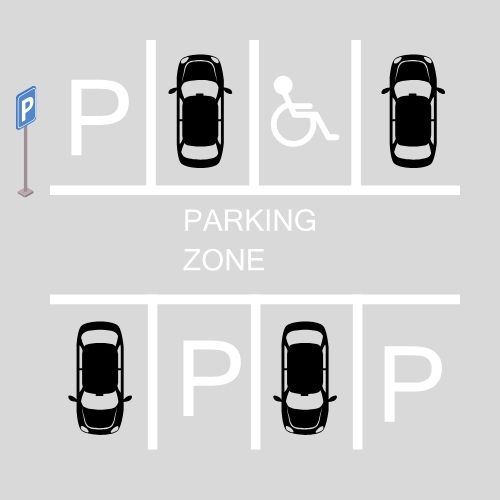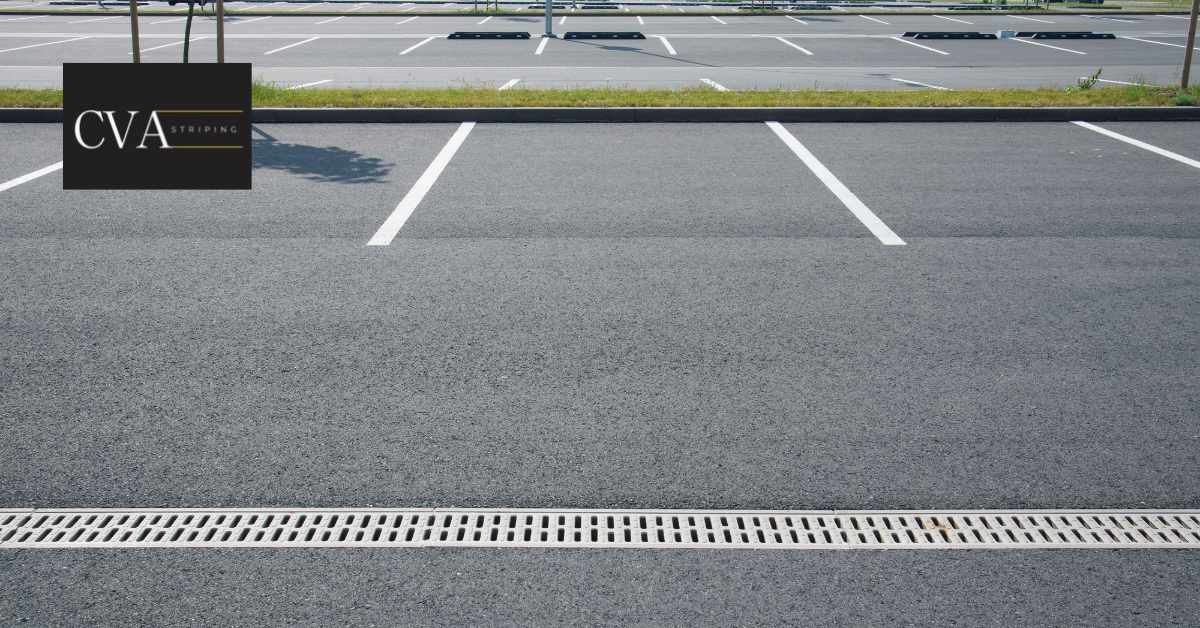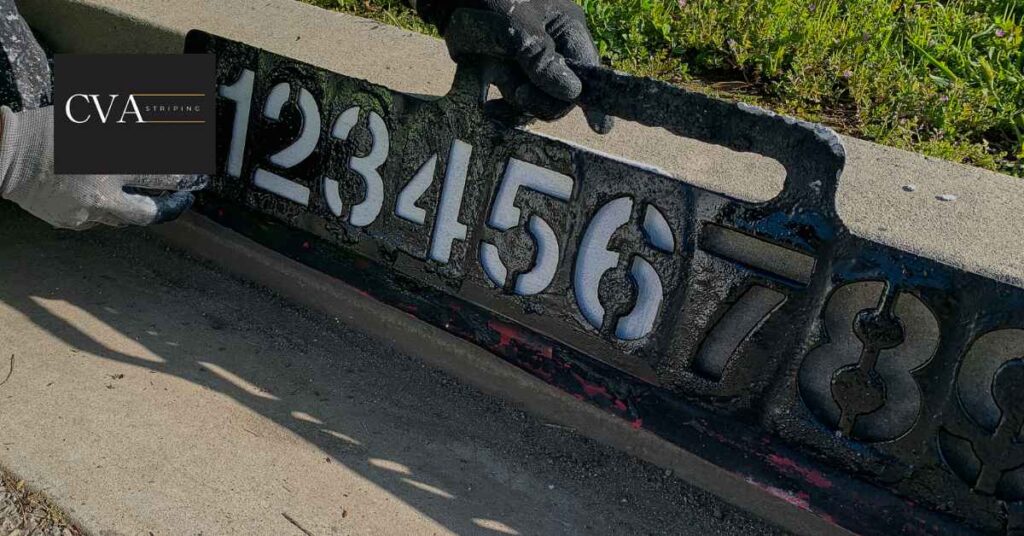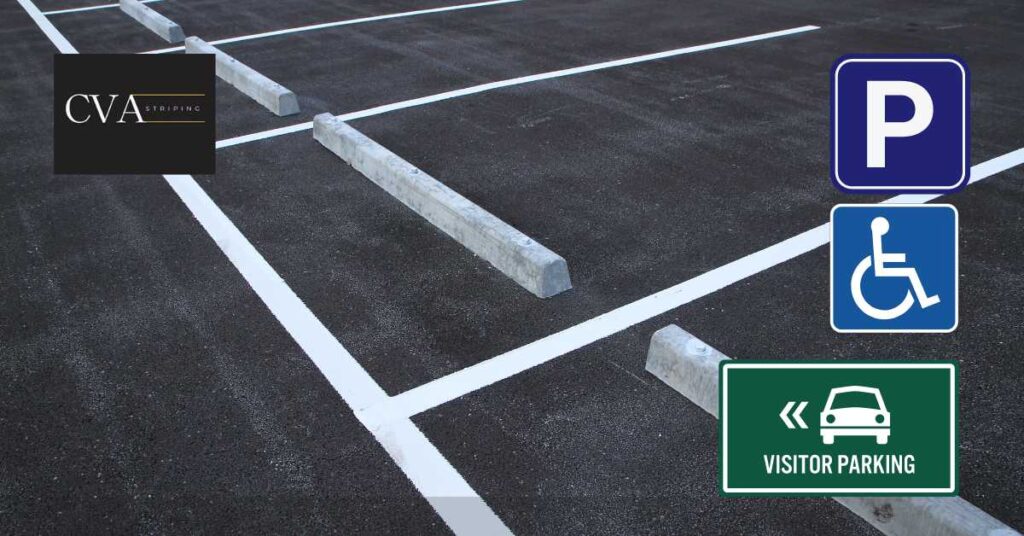Parking lot striping plays a pivotal role in ensuring the orderly flow of traffic, enhancing safety for drivers and pedestrians, and maximizing space utilization. However, your parking lot striping standards must adhere to specific guidelines.
Here, we will delve into what makes for standard parking space dimensions, covering the gamut from legal requirements, such as ADA compliance, to the choice of materials. We’ll explore how these standards apply to different types of parking lots, from small retail complexes to large public spaces, and why adhering to these guidelines is critical for compliance and creating welcoming and user-friendly environments.
Join CVA Line Striping as we navigate the world of parking lot striping standards and discover how these guidelines contribute to safer, more efficient, and more accessible parking areas.
List of Topmost Standard Parking Space Dimensions
Before directly jumping into the list of the standards, it’s necessary to know that the parking lot striping standards are not arbitrary; they are carefully considered to balance the efficient use of space with the ease of parking for drivers. In this section, we will explore the list of topmost standard parking space dimensions, providing a foundational guide for those looking to design or optimize parking facilities.
Compliance with ADA Guidelines
Compliance with the Americans with Disabilities Act (ADA) guidelines is crucial for parking lot striping services, as it ensures that parking facilities are accessible and usable for individuals with disabilities. ADA guidelines specify the accessible parking space spaces, including van-accessible spaces and dimensions of these spaces to accommodate vehicles of various sizes, including those that require additional space for wheelchair lifts or ramps. Adhering to ada parking lot striping standards in parking lot striping ensures legal compliance and demonstrates a commitment to inclusivity and accessibility.
Visibility and Material Use
The effectiveness of parking lot striping hinges on parking lot striping color standards, which, in turn, depends on the materials used. Thermoplastic, paint, and reflective tapes are commonly used for durability and visibility. Thermoplastic, for instance, is known for its longevity and reflective properties, making it an excellent choice for high-traffic areas. Paint, infused with reflective beads, offers a cost-effective solution with good visibility. Reflective tapes provide an immediate high-visibility option that can be quickly applied and replaced as needed. The professional application of these materials ensures that the stripes are straight, uniform, and meet regulatory standards.
Spacing and Size Specifications
When it comes to parking lot striping, adhering to precise spacing and size specifications is crucial for optimizing the functionality and safety of the space. These specifications are designed to accommodate a variety of vehicles, ensure smooth traffic flow, and provide sufficient room for drivers and pedestrians to move safely. Adhering to accessible parking spaces:
| Total Number of Parking Spaces Provided in a Parking Lot or Facility | Minimum Number of Accessible Parking Spaces Permitted |
|---|---|
| 1 to 25 | 1 |
| 26 to 50 | 2 |
| 51 to 75 | 3 |
| 76 to 100 | 4 |
| 101 to 150 | 5 |
| 151 to 200 | 6 |
| 201 to 300 | 7 |
| 301 to 400 | 8 |
| 401 to 500 | 9 |
| 501 to 1000 | 2 percent of total |
| 1001 and over | 20, plus 1 for each 100, or fraction thereof, over 1000 |
| At least one of every six spaces must be van |
Fire Lane and Emergency Access
Ensuring clear fire lanes and emergency access in parking lots is regulatory compliance and a critical aspect of public safety and property protection. Fire lanes are designated areas marked with visible signs and striping to deter parking or blocking by vehicles and other obstacles. It is essential to ensure striping standards for parking lots that these critical pathways remain clear and accessible, while the obstructions also result in significant fines and legal liabilities for property owners. Hence, prioritizing the visibility and accessibility of fire lanes and emergency access is fundamental to building safety and emergency preparedness.
Traffic Flow Design
By incorporating clear, strategically placed markings, directional arrows, and signage, parking lots can significantly improve the overall efficiency of vehicle movement. This planning enhances safety by reducing the potential for accidents and contributes to a more positive user experience. Drivers are guided smoothly from entry to the parking space and back to the exit, minimizing the risk of bottlenecks and enhancing the functionality of the space. Investing in a professional traffic flow design is not just about adhering to standards; it’s about creating an orderly environment that efficiently serves all users’ needs.

Crosswalks and Pedestrian Safety
Crosswalks are crucial in enhancing pedestrian safety in parking lots and urban environments. They serve as designated zones where pedestrians can safely cross, guiding them away from moving vehicles and reducing the risk of accidents. Properly marked and visible crosswalks are essential for alerting drivers to areas of potential pedestrian traffic, prompting them to slow down and proceed with caution. By prioritizing pedestrian pathways and marking crosswalks, businesses, and municipalities can significantly improve the safety and well-being of all individuals navigating these spaces, fostering a more pedestrian-friendly environment.
Maintenance and Upkeep
Regular maintenance and upkeep of your standard parking space dimensions extends its lifespan and ensures it remains safe and visually appealing. It involves not just the periodic reapplication of striping but also attending to cracks, potholes, and other forms of wear and tear that can occur over time. Additionally, a well-maintained parking lot reflects positively on the image of the business or facility, indicating a commitment to quality and safety. Engaging in routine maintenance activities, such as cleaning, seal coating, and prompt repairs, safeguards your investment and contributes to a positive impression among users.
Signage and Information
Effective signage and information dissemination serve as crucial parking lot management, which is a silent guide for both drivers and pedestrians. Clear, visible signs direct traffic flow, enhancing safety and efficiency and communicating important information such as parking rules, hours of operation, and emergency contact details. Proper signage dimensions of typical parking space is about making spaces accessible and navigable for everyone, ensuring a seamless and positive experience from the moment someone enters the lot. According to American National Standards following is a comprehensive collection of standards guiding the design, evaluation, and use of safety signs, colors, and symbols intended to prevent personal injury by visually alerting people to potential hazards:
ANSI/NEMA Z535.1-2006 (R2011), Safety colors
This ANS establishes technical definitions, color standards, and color tolerances for the ANSI Z535 safety colors.
ANSI Z535.2-2011, Environmental and facility safety signs
This standard guides the design, application, and use of safety signs in facilities and in the environment through consistent visual layout. Reorganized to more clearly describe the five types of safety signs used in facilities, the 2011 edition has also been updated to better harmonize with other parts of the ANSI Z535 series.
ANSI/NEMA Z535.3-2011, Criteria for safety symbols
This document provides general criteria for the design, evaluation, and use of safety symbols to identify and warn against specific hazards, and to provide information to avoid personal injury.
ANSI/NEMA Z535.4-2011, Product safety signs and labels
ANSI/NEMA Z535.4-2011 establishes performance requirements for the design, application, use, and placement of safety signs and labels on a wide variety of products. Revisions to the standard include a new product safety sign, as well as updated definitions to more clearly delineate a separation between physical injury and other safety-related issues.
ANSI/NEMA Z535.5-2011, Safety tags and barricade tapes (for temporary hazards)
This ANS covers the design, application, and use of safety tags and barricade tapes for temporary hazards.
ANSI/NEMA Z535.6-2011, Product safety information in product manuals, instructions, and other collateral materials
ANSI/NEMA Z535.6 lays out requirements for the clear and consistent communication of safety information for a wide array of products. Specifically, the standard addresses collateral information, which includes printed or electronic documents that accompany a product in the form of owner’s manuals, maintenance instructions, assembly instructions, and user guides. ANSI Z535.6-2006 seeks to establish a uniform layout to ensure that important safety information will be communicated effectively and consistently with other safety signs and labels that might also be in use.
ANSI/NEMA Z535-2011, Safety color chart
The safety color chart includes updated and corrected information on ink specifications for the Z535 safety colors.
ANSI/NEMA Z535 SET
This comprehensive collection includes all six parts and the color chart.
Loading Zones and Special Areas
Designating typical parking spot dimensions for loading and unloading is crucial for maintaining efficient operations, especially for businesses that receive regular shipments or have high customer turnover. Properly marked loading zones ensure delivery vehicles have clear, dedicated parking spaces, reducing congestion and minimizing disruptions to traffic flow. These strategically placed zones streamline loading and unloading goods and enhance safety by keeping heavy and potentially hazardous vehicle movements away from pedestrian areas.
Local Regulations and Codes
Navigating the maze of local regulations and codes is vital before undertaking any parking lot striping project. Each municipality may have its own set of guidelines dictating dimensions of typical parking space and requirements for handicapped-accessible parking, among others. Compliance with these regulations ensures not only the legality of the parking layout but also its functionality and safety for users. Businesses and property owners are advised to consult with local planning departments or engage professional striping services familiar with the regional codes to guarantee their parking lots meet all legal standards, thereby avoiding potential fines and rework.
Outcome
Now, talking about the outcome of investing in following parking lot striping guidelines for standard parking space dimensions extends beyond mere aesthetic enhancement; it is a strategic move towards improving safety, maximizing space utilization, and boosting overall property value. Moreover, the visual appeal of a freshly striped parking lot creates a positive first impression on customers, potentially increasing foot traffic and, by extension, business revenue. Regular maintenance and re-striping protect the property owner from potential liabilities and are cost-effective solutions to prolong the parking lot’s lifespan. Ultimately, employing parking lot striping services results in a safer, more efficient, and aesthetically pleasing environment for all users, underscoring the importance of such an investment in today’s competitive business landscape.




